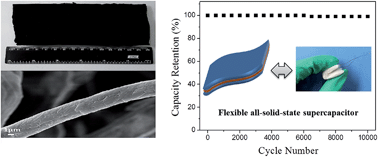Scalable fabrication of exceptional 3D carbon networks for supercapacitors†
Abstract
Supercapacitors prepared using three-dimensional porous carbon networks, such as graphene- and carbon nanotube-based aerogels, have attracted extensive attention in numerous fields. However, undesirable properties, including high cost, complicated fabrication processes, and insufficient yields, have greatly restricted the large-scale practical applications of such supercapacitors. In this study, a facile and exclusive approach is presented toward the scalable preparation of novel 3D porous carbon networks using relatively low-cost commercial cotton. Capacitive electrode materials for supercapacitors and corresponding flexible devices have been achieved based on tailoring the chemical composition, surface area and pore size distribution of the carbon networks via conventional carbonization and activation. These exceptional 3D porous carbon networks with controllable properties have shown high specific surface areas of up to 1563 m2 g−1 and optimized energy storage capabilities of 314 and 170 F g−1 at current densities of 0.1 and 10 A g−1 in 6 mol L−1 KOH electrolyte, respectively. Consequently, these advantageous features allow the carbon networks to be directly utilized in flexible all-solid-state supercapacitors, which exhibit considerably satisfactory energy storage performance and excellent cycling stability.


 Please wait while we load your content...
Please wait while we load your content...